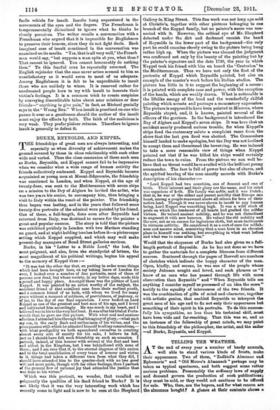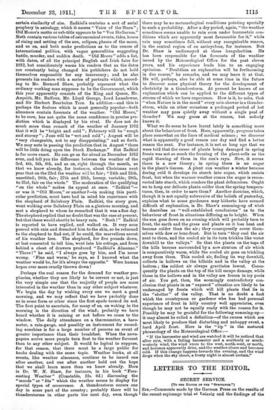TELLING THE WEATHER.
AT the end of every year a number of hardy annuals. well able to stand various kinds of frosts, make their appearance. Two of them, " Zadkiers Almanac and Ephemeris" and " Old Moore's Almanack " perhaps may be taken as typical specimens, and both suggest some rather curious problems. Presumably the ordinary laws of supply and demand govern the production of such publications- they must be sold, or they would not continue to be offered for sale. 'Who, then, are the buyers, and for what reason are the allasaftee bought? A glance at their contents shows a certain similarity of aim. Zadkiel's contains a sort of serial prophecy in astrology, which it names " Voice of the Stars " ; Old Moore's motto or sub-title appears to be " Vox Stellarum." Both contain various tables of astronomical events, tides, hours of rising and setting of the sun, eclipses, phases of the moon, and so on, and both make predictions as to the course of international politics, with vague generalities suggesting battle, murder, and sudden death. "Old Moore" adds a list, with dates, of all the principal English and Irish fairs for 1912, but considerately warns his readers that as the dates are constantly being changed his publishers do not hold themselves responsible for any inaccuracy ; and he also presents his readers with a series of portraits which, accord- ing to Mr. Bernard Shaw, probably represent what the ordinary working man supposes to be the Government, which this year apparently consists of the King and Queen, Mr. Asquith, Mr. Balfour, Mr. Lloyd George, Lord Lansdowne, and Sir Herbert Beerbohm Tree. In addition—and this is perhaps the feature which is most generally popular—both almanacs contain forecasts of the weather. " Old Moore," to be sure, has not quite the same confidence in precise pre- diction which is displayed by his rival. He does not do much more than remark of the weather of January 1912 that it will be "bright and cold " ; February will be "rough and stormy " ; June will be "wet and cold" ; August will be "very changeable, not to say disappointing," and so forth. We may note in passing the prediction that in August " there will be little doing upon the Stock Exchange." But Zadkiel is far more exact. He can go as far ahead as December 1912 even, and tell you the difference between the weather of the 3rd, 4th, 5th, 6th, and so on, right through the month, so that we know already, for instance, about Christmas next year that on the 23rd the weather will be fair ; " 21th and 25th, unsettled; 26th, fair; 27th and 28th, breezy, variable ; 29th, to 31st, fair on the whole." The moderation of the qualifying " on the whole " makes its appeal at once. " Zadkiel "- or was it " Old Moore," or another P—in making this parti- cular prediction, must have had in mind his experience with the shepherd of Salisbury Plain. Zadkiel, the story goes, went walking over Salisbury Plain on a glorious morning, and met a shepherd to whom he remarked that it was a fine day. The shepherd replied that no doubt that was the case at present, but that there would shortly be heavy rain. " Bosh ! " Zadkiel is reported to have replied, and walked on. It very soon poured with rain and drenched him to the skin, so he returned to the shepherd to find out, if he could, the marvellous secret of his weather lore. The shepherd, for five pounds down, at last consented to tell him, went into his cottage, and from behind a chest of drawers produced "Zadkiel's Almanac." " There !" he said, " I always goes by him, and I'm never wrong. Fine and warm,' he says, so I kn owed what the weather would be, for it's always the opposite." Were human hopes ever more cruelly thrown down !
Perhaps the real reason for the demand for weather pro- phecies, whether they are likely to be correct or not, is just the very simple one that the majority of people are more interested in the weather than in any other subject whatever. We begin the day by wishing every one we meet a good morning, and we may reflect that we have probably done so in some form or other since the first spade turned its sod. The first point to ascertain, for many of us, on waking in the morning is the direction of the wind; probably we have beard whether it is raining or not before we come to the window. The daily attendance on a thermometer, a baro- meter, a rain-gauge, and possibly an instrument for record- ing sunshine is for a large number of persona an event of greater importance than their breakfast. When the news- papers arrive more people turn first to the weather forecast than to any other subject. It would be logical to suppose, for that reason, that there must be a large public for books dealing with the same topic. Weather books, at all events, like weather almanacs, continue to be issued one after another, and one after another hold out the hope that we shall learn more than we know already. Here is Dr. W. N. Shaw, for instance, in his book "Fore- casting Weather" (Constable, 12s. 6d.) discussing the "moods" or " fits " which the weather seems to display for special types of occurrence. A thunderstorm occurs one day in some part of the country; probably there will be thunderstorms in other parts the next day, even though there may be no meteorological conditions pointing specially to such a probability. After a dry period, again, " the weather sometimes seems unable to rain even under barometric con- ditions which are apparently most favourable for it," while rain may sometimes fall, without any recognizable reason,
in the central region of an anticyclone, for instance. But Dr. Shaw is undismayed at these irregularities. He has been responsible for the forecasts of the weather issued by the Meteorological Office for the past eleven
years, and his experience leads him to an engaging optimism. "Doubtless an explanation will be forthcoming in due course," he remarks, and we may leave it at that. He will, perhaps, also be able at some time in the future
to discover some physical theory for the development of electricity in a thunderstorm. At present he knows of no
explanation which can be applied to the different types of storms of which we have experience. How is it, be asks, that " when Nature is in the mood" every rain-shower is a thunder. storm, while on other occasions a prolonged period of hot
weather may pass quietly away without a single peal of thunder P We may guess at the reason, but nobody knows it.
What we do seem to have learnt lately is something more about the behaviour of frost. Here, apparently, progress takes place somewhat on the lines of medical science ; we discover what is apparently a good reason one day and find a better reason the next. For instance, it is not so long ago that we were told that the cause of plants being damaged in spring frosts was not so much the freezing of the plant-cells as the
rapid thawing of them in the sun's rays. Now, it seems there is a new theory ; in spring there is no sugar in the plant's tissues. A plant can weather a winter because
during cold it develops its starch into sugar, which resists frost, but when the warmer weather comes the sugar is recon- verted into starch, which renders the plant defenceless. Ought we to keep our delicate plants colder than the spring tempera- tures, then, in order to save them P Another doctrine, which,
though it is not equally subversive of the beliefs of yesterday, explains what to some gardeners may hitherto have seemed difficult of explanation, is Dr. Shaw's summing-up of what he describes as " well-established conclusions " as to the behaviour of frost in situations differing as to height. When the sun goes down on an evening which will probably turn to frost, the earth and the grass and plants on it lose heat and become colder than the air ; they consequently cover them- selves with dew or boar-frost. But in turn "they cool the air next to them, and the cooled air in its turn trickles like water downhill to the valleys." So that the plants on the tops of the hills become surrounded by a new stratum of air which
is comparatively warm, while the cooled air goes on trickling away from them. This cooled air, finding its way downhill, collects in hollows on the hillside and in the valley at the bottom ; the coldest air always gravitates lowest. Conse- quently the plants on the top of the hill escape damage, while those in the hollows and in the valley are frozen in icy pools
of air. You get, then, the seemingly contradictory con- clusion that plants in an " exposed " situation are likely to be undamaged by frosts which will kill plants that lie in the "shelter" of the valley. That is no doubt a fact which the countryman or gardener who has had personal experience of frost in hilly country well appreciates, even though be may not be equally ready with the reason for it. Possibly he may be grateful for the following summing-up— it may almost be called a definition—of the causes which are
most likely to produce that disturbing and unhappy event, a hard April frost. Here is the " tip " in the matured phraseology of the Meteorological Office :—
" If the barometer and wind are watched it will be noticed that after rain, with a falling barometer and a southerly or south- westerly wind, the wind veers to the west, north-west, or north, and becomes apparently drier, and the weather clears and becomes cold. If this change happens towards the evening, and the wind drops when the sky clears, a frosty night is almost certain."



































 Previous page
Previous page